Related Research Articles

A V6 engine is a six-cylinder piston engine where the cylinders share a common crankshaft and are arranged in a V configuration.
Buick is a division of the American automobile manufacturer General Motors (GM). Started by automotive pioneer David Dunbar Buick in 1899, it was among the first American automobile brands and was the company that established General Motors in 1908. Before the establishment of General Motors, GM founder William C. Durant had served as Buick's general manager and major investor. With the demise of Oldsmobile in 2004, Buick became the oldest surviving American carmaker.

Pontiac, or formally the Pontiac Motor Division of General Motors, was an American automobile brand owned, manufactured, and commercialized by General Motors. It was originally introduced as a companion make for GM's more expensive line of Oakland automobiles. Pontiac quickly overtook Oakland in popularity and supplanted its parent entirely by 1933, in turn establishing its position as one of GM's dominant divisions.

The straight-eight engine or inline-eight engine is an eight-cylinder internal combustion engine with all eight cylinders mounted in a straight line along the crankcase. The type has been produced in side-valve, IOE, overhead-valve, sleeve-valve, and overhead-cam configurations.

The inline-six engine is a piston engine with six cylinders arranged in a straight line along the crankshaft. A straight-six engine has perfect primary and secondary engine balance, resulting in fewer vibrations than other designs of six or fewer cylinders.
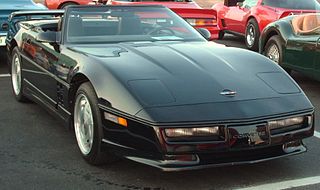
The Y platform, or Y body, designation has been used twice by the General Motors Corporation to describe a series of vehicles all built on the same basic body and sharing many parts and characteristics. The first was for a group of entry-level compacts including the conventional front-engine compacts built by GM divisions Buick, Oldsmobile and Pontiac from 1961 to 1963. The second, and current, incarnation is used for a high-end rear-wheel drive sports-car platform from the 1970s through the 2000s.

The General Motors 60° V6 engine family is a series of 60° V6 engines produced for both longitudinal and transverse applications. All of these engines are 12-valve cam-in-block or overhead valve engines, except for the LQ1 which uses 24 valves driven by dual overhead cams. These engines vary in displacement between 2.8 and 3.4 litres and have a cast-iron block and either cast-iron or aluminum heads. Production of these engines began in 1980 and ended in 2005 in the U.S., with production continued in China until 2010. This engine family was the basis for the GM High Value engine family. These engines have also been referred to as the X engines as they were first used in the X-body cars.

The Buick V6 is an OHV V6 engine developed by the Buick division of General Motors and first introduced in 1962. The engine was originally 198 cu in (3.2 L) and was marketed as the Fireball engine. GM continued to develop and refine the 3.8 L (230 cu in) V6, eventually and commonly referred to simply as the 3800, through numerous iterations.

The Buick V8 is a family of V8 engines produced by the Buick division of General Motors (GM) between 1953 and 1981. All were naturally aspirated OHV pushrod engines, except for a turbocharged version of the Oldsmobile Jetfire 215.
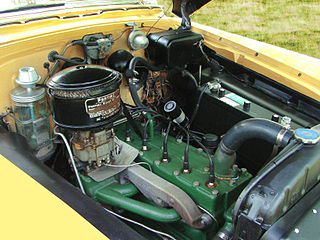
The Pontiac straight-8 engine is an inline eight-cylinder automobile engine produced by Pontiac from 1933 to 1954. Introduced in the fall of 1932 for the 1933 models, it was Pontiac's most powerful engine at the time and the least expensive eight-cylinder engine built by an American automotive manufacturer. During its 21-year run displacement of the "eight" increased twice as platforms grew. It was superseded by Pontiac's new V8, the 287, in 1955. Engine block and cylinder heads were cast at Saginaw Metal Casting Operations then assembled at Tonawanda Engine before delivery to Pontiac Assembly for installation.

The Buick straight-8 engine was produced from 1931 to 1953 and sold in Buick automobiles, replacing the Buick Straight-6 engine across the board in all models in 1931. Like many American automobile makers, Buick adopted the straight-eight engine in 1931 as a more powerful alternative to the previous engines.
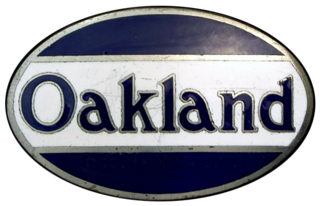
The Oakland Motor Car Company of Pontiac, Michigan, was an American automobile manufacturer and division of General Motors. Purchased by General Motors in 1909, the company continued to produce modestly priced automobiles until 1931 when the brand was dropped in favor of the division's Pontiac make.

The GM Family I is a straight-four piston engine that was developed by Opel, a former subsidiary of General Motors and now a subsidiary of PSA Group, to replace the Vauxhall OHV, Opel OHV and the smaller capacity Opel CIH engines for use on small to mid-range cars from Opel/Vauxhall. The engine first appeared in the Opel Kadett D in 1979, and shortly afterwards in its Vauxhall badged sister – the Vauxhall Astra Mk.1 in 1980. Despite this, the previous Opel OHV engine continued to be sold in entry level versions of the Opel Kadett/Astra and Corsa throughout the 1980s.

Marquette was an American automobile manufacturer established by General Motors in 1909 after the purchase of the Rainier Motor Car Company. The Marquette Company did not last long and in 1912 GM announced the company would be closed.

The Hackett was an automobile built in Jackson, Michigan, United States, by the Hackett Motor Car Company from 1916 to 1919.
The Holden straight-six motor is a series of straight-six engine that were produced by General Motors Holden at their Port Melbourne plant between 1948 and 1986. The initial Grey motor was so dubbed because of the colour of the cylinder block, later motors came in the form of a Red, Blue, Black, and the four-cylinder Starfire engine. These engines were fitted to all Australian designed Holdens of the same years, and the four-cylinder Starfire notably also found its way into the Toyota Corona (XT130). The Grey motor is a different engine from the others, while the Red, Blue, Black, and even the Starfire are all inter-related with many common parts and castings.
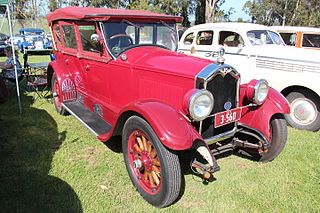
The Buick Standard Six Series 20 was manufactured by Buick at what would later become known as the Buick City factory on Hamilton Ave. in Flint, Michigan, and was the junior model to the Buick Master Six between 1925 through 1929, and shared the GM A platform with Oldsmobile, Oakland and Chevrolet. The Standard Six evolved from the earlier Buick Six when the Buick 4-cylinder was cancelled. The Standard Six was the most popular Buick sold while being more upscale to the Oldsmobile Six. It was the senior brand to Marquette under the General Motors Companion Make Program until Marquette was cancelled one year later. It replaced the earlier Buick Six that was introduced in 1916, and was replaced with the Buick Series 50. Coachwork continued to be offered by Fisher Body who was the primary supplier of all GM products at this time, and Duco automotive lacquer paint, introduced by DuPont was the first quick drying multi-color line of nitrocellulose lacquers made especially for the automotive industry.
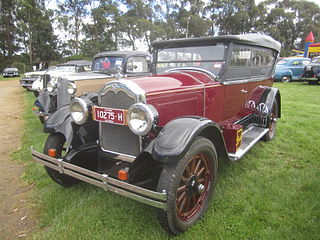
The Buick Master Six, also denoted Series 40 and Series 50 based on the wheelbase used, was an automobile built by Buick from 1925 to 1928 and shared the GM B platform with the Oldsmobile Model 30. Previously, the company manufactured the Buick Six that used the overhead valve six-cylinder 242 cu in (4.0 L) engine in their high-end cars, and the Buick Four for smaller, less-expensive cars. After 1924, they dropped the four-cylinder engine and designed a small six, which they called the Buick Standard Six, to replace that end of the market. They coined the name "Master Six" for the high-end cars, now powered by the 255 cu in (4.2 L) engine released the year before. The yearly changes were a result of a new business philosophy called planned obsolescence.

The Oldsmobile F-Series was a pre-WWII passenger car built from the 1928 through 1938 model years. The first generation continued the tradition of adding a series number for each model year; F-28, F-29, F-30 and F-31. The second generation, signified by a completely new bodystyle appearance was built from 1932 through 1938, all having been manufactured in Lansing, Michigan. 1926 saw the introduction of GM's most recognized business model, the use of common platforms shared amongst the brands, and Oldsmobile and Buick shared the GM B platform. The F-Series was shared with the Buick Master Six and was also known as the Oldsmobile Six which was introduced as a name earlier in 1913.
References
- ↑ Kimes, Beverly (1996). Standard catalog of American Cars 1805–1942 (third ed.). Krause publications. pp. 162–192. ISBN 0-87341-478-0.
- Slauson, H. W.; Howard Greene (1926). "Leading American Motor Cars”. Everyman’s Guide to Motor Efficiency. New York: Leslie-Judge Company.